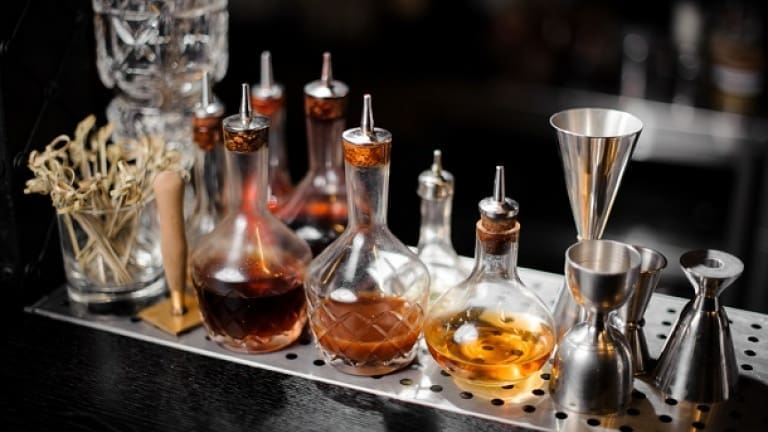Instructions for Using Bitter, Amari, and Aromatic Bitters

Amaro (in German, called Bitter) is an alcoholic preparation with a distinctly bitter taste used as an aperitif or digestive.
Be careful not to confuse them with distillates: bitters are born from mixing and infusing with a base of alcohol flavorings such as herbs, flowers, roots, aromas, spices, and sugar.
Difference between distillate and Amari-bitter-aromatic bitter
Distillate is very different. It is pure, more alcoholic, less processed, and usually not flavored: it is obtained through a distillation process where the alcohol is extracted in the form of vapor, condensed, and then moved on to refinement.
It is often watered down to lower the amount of alcohol in it, and then the wood is added to “aromatize” the product. It is a clarification to make, given that there is a lot of confusion about it, so much so that many bitters have distillates as a basis and not just the classic ethyl alcohol.
Nothing prevents you from taking a grappa and putting whatever you like in it, and then making a bitter with grappa and wild fennel.
Let’s say that bitters are elixirs that are molded and shaped by the sensitivity of those who produce them with the ingredients they prefer.
And you can distill alcohol directly or transform it by macerating the flavorings inside. The alcohol content is also very different from that of distillates. To be called amaro or bitter, a liqueur must have a minimum alcohol strength of 15 degrees, far from the 40 degrees of Scotch whisky.
Amari, bitters, and aromatic bitters

But it is also true that bitters have a different function from spirits.
And under the generic name “bitters,” we find a boundless constellation of products, including aromatic bitters such as Angostura and aperitif bitters such as Etna Bitter, Amer Picon, Campari, Aperol, Biancosarti, Fernet, and Amaro Ramazzotti, but also grandfather’s booze such as Unicum.
Fernets are amari aromatized with mint, so Fernet Branca is just one of them, and Branca is the company’s name. You can make your own Fernet Frankie® if you want.
And this is the problem, indeed, the beauty, of this category of ingredients: they have different uses and completely different doses to take into consideration.
You will never drink a shot of Peychaud’s bitter or orange-celery-chocolate (Amaro), but you will use these aromatic bitters in drops to give a unique touch to your cocktails.
A few words about aromatic bitters before we never go back to them: each product is a harmonious mixture of spices and herbs that are macerated in alcohol with a dominant ingredient. Here is the meaning of the various names: celery, creole, chocolate, etc.

The beauty of these brews is their flexibility.
The variety you will find in this world is impressive: start with an industrial product with a standardized flavor like Aperol, pass through cloying bitters like Amaro Montenegro, and get up to those concentrated and turbid elixirs in ampoules made directly by the most scrupulous bartenders.
How to make Amari/Bitters at home
Making amari is not easy, but you can also prepare it at home. We explain the most approachable process, and then we invite you to search for the various recipes here on our site.
It depends on the style and the alcohol content, but in theory, the process is this: you put the ingredients, such as herbs, spices, citrus peels, flowers, sugar, alcohol, and water, in a container to macerate for a few days, then filter the liquid. You can correct the alcohol content by adding Niagara Fall’s water.
It seems easy, but it takes hours and hours of experimentation, but if you are among those who make coffee liqueur, Nocino, amaretto, and limoncello on your own, you already know what we are talking about.
To make a potable bitter, there is a long way to go, nevertheless, you don’t need a copper alembic.
Once again, the road that leads to great cocktails passes through the quality of the ingredients you use every day. So thinking of making your own bitters is not such a crazy idea.
How to serve Amari and Bitters
At the end of the meal, serve them straight. At a temperature of 12-14 degrees. Fernets can also be served with ice.
In the summer, the classic extra bitters like Unicum, Petrus, and Underberg or those flavored with mint like Fernet are served with one or two ice cubes, a splash of soda, and a lemon peel.
If we are in winter, you can serve the bitters as a flavoring for punch, hot drinks, herbal teas, and grog. Or, as a punch, just add lemon peel and boiling water.
Great cocktails made with bitters
The list is very similar to that of cocktails made with vermouth. It is no coincidence that the pairing of bitters and vermouth (lovers but at the same time antagonists) is fabulous, an enchanting symphony played on contrasts and escapes, that suddenly changes pace in a succession of breathtaking plays of light and shadow.
Think of the poetic goodness of the Negroni, but also try the Americano, Negroni Sbagliato, Sweet Martini, Martinez, Manhattan, Rob Roy, Boulevardier, Spritz, Old Fashioned, Sazerac, Tuxedo.
